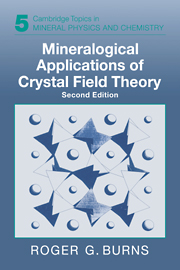Book contents
- Frontmatter
- Contents
- Preface to the first edition
- Preface to the second edition
- 1 Introduction
- 2 Outline of crystal field theory
- 3 Energy level diagrams and crystal field spectra of transition metal ions
- 4 Measurements of absorption spectra of minerals
- 5 Crystal field spectra of transition metal ions in minerals
- 6 Crystal chemistry of transition metal-bearing minerals
- 7 Thermodynamic properties influenced by crystal field energies
- 8 Trace element geochemistry: distribution of transition metals in the Earth's crust
- 9 Mantle geochemistry of the transition elements: optical spectra at elevated temperatures and pressures
- 10 Remote-sensing compositions of planetary surfaces: applications of reflectance spectra
- 11 Covalent bonding of the transition elements
- Appendices
- References
- Subject index
Preface to the second edition
Published online by Cambridge University Press: 23 November 2009
- Frontmatter
- Contents
- Preface to the first edition
- Preface to the second edition
- 1 Introduction
- 2 Outline of crystal field theory
- 3 Energy level diagrams and crystal field spectra of transition metal ions
- 4 Measurements of absorption spectra of minerals
- 5 Crystal field spectra of transition metal ions in minerals
- 6 Crystal chemistry of transition metal-bearing minerals
- 7 Thermodynamic properties influenced by crystal field energies
- 8 Trace element geochemistry: distribution of transition metals in the Earth's crust
- 9 Mantle geochemistry of the transition elements: optical spectra at elevated temperatures and pressures
- 10 Remote-sensing compositions of planetary surfaces: applications of reflectance spectra
- 11 Covalent bonding of the transition elements
- Appendices
- References
- Subject index
Summary
When the first edition of Mineralogical Applications of Crystal Field Theory was written during 1968–9, it broke new ground by describing results and suggesting applications of the limited spectroscopic and crystal chemical data then available for transition metal-bearing minerals. The data were derived mainly from visible to near-infrared spectral measurements, together with newly available Mössbauer-effect studies of iron minerals, made principally at ambient temperatures and pressures. The book stimulated considerable interest among subsequent mineral spectroscopists who have developed new and improved methods to study minerals and synthetic analogues under a variety of experimental conditions, including in situ measurements made at elevated temperatures and pressures. As a result, the quantity of spectral and crystal chemical data has increased appreciably and may now be applied to a diversity of current new problems involving transition elements in the earth and planetary sciences.
The second edition now attempts to review the vast data-base of visible to near-infrared spectroscopic measurements of minerals containing cations of the first-series transition elements that has appeared during the past 20 years. Several newer applications of the spectral and crystal chemical data are described, including interpretations of remote-sensed reflectance spectra used to identify transition metal-bearing minerals on surfaces of planets. This topic alone warrants the inclusion of a new chapter in the second edition. Many of the classical applications of crystal field theory outlined in the first edition are retained, and each of the original 10 chapters is expanded to accommodate fresh interpretations and new applications of crystal field theory to transition metal geochemistry.
- Type
- Chapter
- Information
- Mineralogical Applications of Crystal Field Theory , pp. xxi - xxivPublisher: Cambridge University PressPrint publication year: 1993

